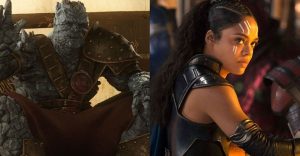Tom & Jerry’s Cartoon World Logic Doesn’t Make Any Sense

Tom & Jerry brings the classic Hanna-Barbera cartoon characters into the human world for the first time ever, but in doing so, it calls into question the movie’s wonky logic with cartoons. The famous cat-and-mouse at the center of the story are still animated, but the way in which the humans in the story interact with them raises logical – and even at times ethical – concerns. While the film delivers a zany, family-friendly story that’s both reminiscent of the classic Tom and Jerry franchise and forward-thinking, it’s certainly not without issue.
Beginning in 1940, William Hanna and Joseph Barbera built their iconic cat-and-mouse story into a cultural mainstay through short films, television programs, and now two theatrically-released movies. Over the course of a 161-short-film run, Tom and Jerry earned the duo seven Academy Awards for Best Animated Short Film. In the latter part of the 20th century, Tom and Jerry featured in several TV series: The Tom and Jerry Show (1975), The Tom and Jerry Comedy Show (1980–1982), Tom & Jerry Kids (1990–1993), Tom and Jerry Tales (2006–2008), and most recently The Tom and Jerry Show (2014–present).
Throughout their history, they’ve enjoyed the luxury of cartoon logic, amplifying the slapstick comedy for which the duo is so renowned. But integrating these “cartoon world” characters into the “real” world poses some unique challenges. Who Framed Roger Rabbit? (1988) had to reconcile the two worlds’ logic, as did Space Jam (1996). In Tom & Jerry (2021), the writers made a few choices to execute this: all animals are cartoon characters, the animals behave as if they are sentient beings, and they can’t speak to humans. While some of these decisions make sense, others leave audiences scratching their heads while the credits roll, as more unsightly implications present themselves upon further review.
All Animals Are Cartoons, But Nothing Else is

Avoiding the photorealistic animated look of other live-action/animated hybrids, like Garfield: The Movie (2004) or the Chipmunks films, Tom & Jerry chooses to render its leading cat and mouse in a style much more reminiscent of their cartoon origins. In fact, the movie justifies this choice by making all the animals in the world of the film into these 2D-cartoonish characters who are lit and shaded in 3D. From the opening titles, the audience is introduced to this concept via a pigeon singing A Tribe Called Quest’s “Can I Kick It”. Later, exterior shots of New York City show regular background extras walking their clearly-animated pets on leashes. While all other elements maintain their realism, strictly the animals are animated.
This decision attempts to find a happy medium between the real world and the cartoon world for Tom & Jerry. No human characters acknowledge the animated-ness of their animal counterparts, and they similarly don’t acknowledge the zaniness of their cartoon stunts. The repeated occurrence of an “animal tornado” makes no greater impact on any given scene than the literal damage it causes. It’s less “how did these animals disappear into a raging torrent of cartoon dust,” and more “what a mess this in-no-way-physically-unusual phenomenon has caused.” Clearly, the human characters believe the supernatural abilities of these animals to be commonplace. What’s more, they even regularly acknowledge some animals as sentient, motivated characters.
Its Not Clear if Humans See Animals as Sentient Or Not

Tom & Jerry introduces the titular cat as he’s busking, pretending to be blind. Human characters surround him, contributing money to his cause. With this exchange, it’s clear these people regard Tom as a fellow consumer, who would have need for money to survive in society. They also express disgust at his fake blindness when Jerry exposes his grifting scheme, and therefore regard Tom as fair game for emotional and character judgements. By all accounts, he’s functionally a fellow human character, albeit mute. Tom later gets a job at the hotel, where Kayla acknowledges his innate cat-ness to suggest he’d make a good solution to the mouse problem.
But Tom & Jerry wants to have its cake and eat it too; it treats Tom and Jerry as sentient characters, but also treats its other animals as though they were merely ‘regular’ animals. The bride and groom keep pets, as do many background extras, begging the question that if these are sentient beings, at what point does that raise ethical concerns? The hotel suggests hiring an exterminator at one point, which suggests that although the animals are sentient, their lives are still treated as are vermin in certain situations. Tom endures all manner of kicking and other physical abuse, which wouldn’t be okay whether he was a fellow human character or a non-sentient, ‘normal’ cat. Cameron the bartender is surprised that Kayla can understand Tom and Jerry’s charades, and yet he didn’t bat an eye at the utter strangeness of the earlier animal tornado. The movie vacillates between treating its animals as functionally-human and functionally-non-sentient whenever it best suits the story.
Tom Can’t Talk, But He Can Sing, But He Doesn’t Sing to Communicate

The original sin of the first Tom and Jerry movie to get a theatrical release was that it gave its famously mute characters voices. Tom & Jerry (2021) atones for this by keeping them silent – mostly. Several of Tom’s outbursts in the film are actually pulled from archival recordings, including those from co-creator William Hanna himself. These don’t amount to much insofar as “communicating,” but in one scene, Tom is moved to song by the alluring Toots Galore. The sultry auto-croon of T-Pain gives voice to Tom’s emotions, but more importantly, to Tom. If Tom can eschew his mute-ness by singing, why doesn’t he utilize this ability later in the film when a quick explanation would save he and Kayla valuable time during the climax? Tom & Jerry may have its logical inconsistencies, but the filmmakers managed to create something true to the original spirit of the cartoon while freshening the IP for a new, modern audience.
About The Author

















